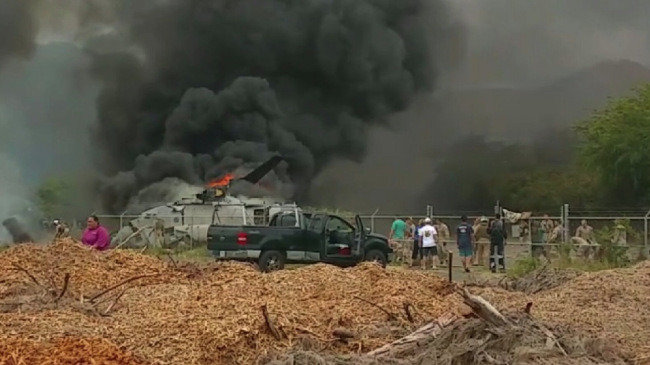Photo: Ken Quinata/KHON
Planet Earth seems to be experiencing a period of geophysical turbulence. Molten magma on the move. Earthquake clusters near the crater of Kilauea. The lava lake of Halemaʻumaʻu exploding and overflowing its banks, then subsiding. Earthquakes and volcanic eruptions at tectonic hotspots around the worlds including Papua New Guinea, Indonesia, Japan, and the terribly deadly swarm of quakes that killed thousands in Nepal.
The turbulence is also social and political. From #Blacklivesmatter demonstrations in Baltimore and other U.S. cities, to the worldwide #kukiaimauna #wearemaunakea protests against the Thirty Meter Telescope on sacred Mauna Kea, from kayaktivists blockading the Shell oil platform in Puget Sound, to Okinawans protesting on land and sea against the massive new reef-destroying Marine Corps base in Henoko, Okinawa, social relations are churning.
And now turbulence of the fluid dynamic sort, it seems, may have brought down a Marine Corps MV-22 Osprey tilt-rotor aircraft in a deadly crash in Waimānalo, Hawaiʻi that killed one two marines and injured 20 others. Watch this cellphone video of the crash:
Hawaii News Now – KGMB and KHNL
In the video, a large cloud of dust is kicked up by the powerful rotors. You can see the Osprey descending quickly, apparently with enough speed that the cameraperson expresses alarm. The aircraft hits the ground in the dust cloud and pieces can be seen flying off. Then flames and thick black smoke envelope the airplane followed by a fireball.
The Marines called it a “hard landing” rather than a crash, and the media has continued to parrot that terminology. The spin machine kicked in to minimize the severity of the incident, then to reaffirm the safety of the aircraft. The Marine Corps has an interest minimizing the danger of the Osprey because it has been plagued by deadly accidents and ballooning costs. Despite several attempts by the Pentagon to kill the expensive program, the Marines have been able to bring it back from the dead—zombie militarism—mindless pursuit of the objective despite the costs.
But they cannot bring back the dozens of lives lost in Osprey crashes.
The thing is, the Pentagon has known about the hazards of the Osprey for more than ten years. The report V-22 Osprey: Wonder Weapon or Widow Maker? (2006) by Lee Gaillard of the Center for Defense Information states, “They warned us. But no one is listening.”
One of the main problems is what is called a “vortex ring state” (VRS), an aerodynamic conundrum inherent to its dual flight mode design:
We are not talking here about “glitches,” or subcomponent quality control issues, or assembly line carelessness problems. It is an aerodynamic enigma involving highly complex turbulence conditions beyond the analytic capabilities of our most advanced computational fluid dynamics simulations.
Given that the V-22’s dual-mode flight capability (as either helicopter or airplane) requires significant aerodynamic design compromises in its prop blades in an attempt to maximize their efficiency in both flight modes, the blades’ stiff, high-twist (47 degrees) design necessary for the higher speed horizontal flight mode poses severe danger when employed in rapid vertical descent situations likely to be faced in combat. This is, therefore, an essentially irreconcilable design conundrum that unfortunately cannot be ‘resolved.’ (14-15)
The report continues, citing an Operational Testing (OT) report:
As the OT-IIG report states, “When descending at a high rate with low forward speed, the rotor can become enveloped in its own downwash, which can result in a substantial loss of lift. … Should one rotor enter VRS and lose more lift than the other rotor, a sudden roll can result, which quickly couples into a[n inverted] nose-down pitch”17—i.e., an upsidedown nose-first crash. Such a maneuver at low altitude during high rate of descent into a hot landing zone would therefore result in catastrophic loss of the aircraft and all aboard.
This appears to describe what happened in videos of the crash.
The news of the crash has gone international. In Japan and Okinawa in particular, there is intense interest in the danger of the Osprey. A hundred thousand people protested against the stationing of 24 Ospreys in Okinawa. The crash in Hawaiʻi will surely rekindle the opposition.
Several years ago, when the stationing of Osprey in Hawaiʻi was first announced, there was opposition from Kanaka Maoli who did not want an ancient Hawaiian fishing village site to be destroyed by the expanded Osprey hangar, and from neighbors of the Marine Corps Base Hawaii – Kaneohe Bay who feared the noise and safety impacts of the Osprey.
This crash may spark renewed opposition to the Osprey in particular, but also to the military occupation of Hawaiian “ceded” (i.e. stolen Hawaiian Kingdom lands) in Waimānalo. In the late 1990s, the Air Force conducted a series of hearings to discuss the possible closure and transfer of the Bellows Air Force Base land that was deemed “underutilized” after the end of the Cold War. Hawaiian community members wanted that the land be returned. But the Marine Corps wanted the land for its training. And the Commander of the Pacific Command, Admiral Macke (the same person who suggested that the US Marines who raped a 12 year old Okinawan school girl in 1995 should have paid for a prostitute instead) threatened to reduce the military presence in Hawaiʻi if the military didn’t get its way. So the Marines took over most of Bellows and use it for amphibious landing training as well as Military Operations in Urban Terrain (MOUT) training in a mock Afghan village. They even hired and flew in Afghan Americans from California to play Afghan villagers.
The crash coincides with the gathering in Hawaiʻi of military leaders from around the Asia-Pacific region to discuss amphibious combat skills. It’s not clear that the Osprey flights were related to the conference.




